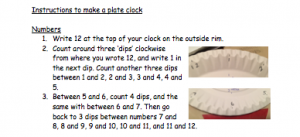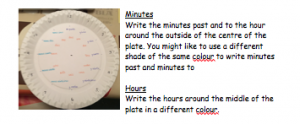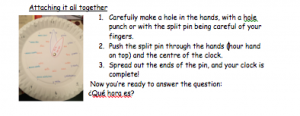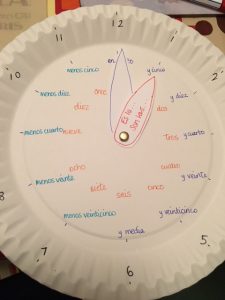Teaching the time is a trying task in any language; I’ve been comparing notes with my Y3 colleagues who have been battling through the time with their classes in Maths lessons as I’ve been working on it with Y5 in Spanish. And back in the day when I taught KS3 and 4 it was also a challenge as I invariably had to ‘remind’ them of how to tell the time full stop! It seems that, for some, the time is viewed much as the gif above – wobbly wobbly and hard to pin down.
So this year I put on my thinking cap and considered what might make it easier. Active things like TimeBallet help with hour and half past, possibly quarter past/to, but tends to get too complicated/fall apart for many with minutes. Singing songs like Uno dos tres ¿Qué hora es? works for the question form and hour/half past. Using mini clocks works for some but I wanted something a bit more supportive. So I decided we’d all make a prop to help them.
Cue the purchase of lots of paper plates and split pins, and the sharing of my gel pens, felt tips and fine liners. The idea – not very original perhaps but quite effective – was to make a personalised plate clock with key phrases on it to support learners as we rehearsed the time.
I demonstrated how to make it but also wrote a set of instructions (in 4 screenshots below and downloadable in one document from here) for the learners to follow after the demonstration, along with providing a larger image plate clock diagram between two so that the writing was clearer.
By putting the hours hand on top of the minute hand, I hoped to emphasise that the hour always comes first, and we wrote the verb Es la/Son las on it to remind learners how the sentence started. And by writing the hours and minutes in separate colours that corresponded to the colour of the hand was another attempt to make it clearer which phrase to use.
 |
 |
 |
 |
Everyone enjoyed making the clocks although some were a little wonky and needed a bit of ‘Sra Stevens magic’ before functioning correctly, and we’ve used them in two lessons now. On the whole, once we got over fiddling with the hands constantly and concentrated, it seemed to help some learners, and it was good to see them being used, much as they use the Maths equipment in numeracy lessons, to help children work out the answers to write in their books as well as in speaking work. Turn the hands to show the time then read the Spanish if the question is in English, or turn the hands so that they match the phrase in Spanish to work out where to draw the hands on a blank clock. Plus the children are all desperate to take them home which I’ve promised they can do once we’ve finished the unit.
There are some other good ideas on how to teach time here from Erzsi and Clare.
I’ve used the clock mini book idea in previous years with success as a self differentiating assessment activity: pupils have to choose six times to demonstrate their understanding and confidence at telling the time so they need to choose carefully those that they know. Might yet do it this year…
If you have any ideas to add, feel free to leave a comment!




